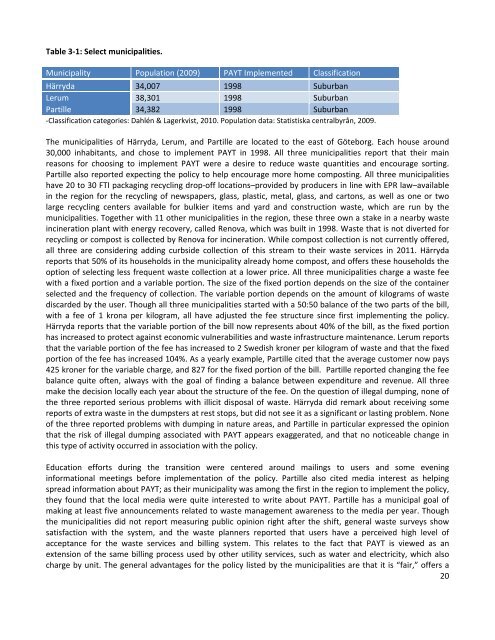Waste prevention and Pay as You Throw, a collective case ... - lumes
Waste prevention and Pay as You Throw, a collective case ... - lumes
Waste prevention and Pay as You Throw, a collective case ... - lumes
Create successful ePaper yourself
Turn your PDF publications into a flip-book with our unique Google optimized e-Paper software.
Table 3‐1: Select municipalities.<br />
Municipality Population (2009) PAYT Implemented Cl<strong>as</strong>sification<br />
Härryda 34,007 1998 Suburban<br />
Lerum 38,301 1998 Suburban<br />
Partille 34,382 1998 Suburban<br />
‐Cl<strong>as</strong>sification categories: Dahlén & Lagerkvist, 2010. Population data: Statistiska centralbyrån, 2009.<br />
The municipalities of Härryda, Lerum, <strong>and</strong> Partille are located to the e<strong>as</strong>t of Göteborg. Each house around<br />
30,000 inhabitants, <strong>and</strong> chose to implement PAYT in 1998. All three municipalities report that their main<br />
re<strong>as</strong>ons for choosing to implement PAYT were a desire to reduce w<strong>as</strong>te quantities <strong>and</strong> encourage sorting.<br />
Partille also reported expecting the policy to help encourage more home composting. All three municipalities<br />
have 20 to 30 FTI packaging recycling drop‐off locations–provided by producers in line with EPR law–available<br />
in the region for the recycling of newspapers, gl<strong>as</strong>s, pl<strong>as</strong>tic, metal, gl<strong>as</strong>s, <strong>and</strong> cartons, <strong>as</strong> well <strong>as</strong> one or two<br />
large recycling centers available for bulkier items <strong>and</strong> yard <strong>and</strong> construction w<strong>as</strong>te, which are run by the<br />
municipalities. Together with 11 other municipalities in the region, these three own a stake in a nearby w<strong>as</strong>te<br />
incineration plant with energy recovery, called Renova, which w<strong>as</strong> built in 1998. <strong>W<strong>as</strong>te</strong> that is not diverted for<br />
recycling or compost is collected by Renova for incineration. While compost collection is not currently offered,<br />
all three are considering adding curbside collection of this stream to their w<strong>as</strong>te services in 2011. Härryda<br />
reports that 50% of its households in the municipality already home compost, <strong>and</strong> offers these households the<br />
option of selecting less frequent w<strong>as</strong>te collection at a lower price. All three municipalities charge a w<strong>as</strong>te fee<br />
with a fixed portion <strong>and</strong> a variable portion. The size of the fixed portion depends on the size of the container<br />
selected <strong>and</strong> the frequency of collection. The variable portion depends on the amount of kilograms of w<strong>as</strong>te<br />
discarded by the user. Though all three municipalities started with a 50:50 balance of the two parts of the bill,<br />
with a fee of 1 krona per kilogram, all have adjusted the fee structure since first implementing the policy.<br />
Härryda reports that the variable portion of the bill now represents about 40% of the bill, <strong>as</strong> the fixed portion<br />
h<strong>as</strong> incre<strong>as</strong>ed to protect against economic vulnerabilities <strong>and</strong> w<strong>as</strong>te infr<strong>as</strong>tructure maintenance. Lerum reports<br />
that the variable portion of the fee h<strong>as</strong> incre<strong>as</strong>ed to 2 Swedish kroner per kilogram of w<strong>as</strong>te <strong>and</strong> that the fixed<br />
portion of the fee h<strong>as</strong> incre<strong>as</strong>ed 104%. As a yearly example, Partille cited that the average customer now pays<br />
425 kroner for the variable charge, <strong>and</strong> 827 for the fixed portion of the bill. Partille reported changing the fee<br />
balance quite often, always with the goal of finding a balance between expenditure <strong>and</strong> revenue. All three<br />
make the decision locally each year about the structure of the fee. On the question of illegal dumping, none of<br />
the three reported serious problems with illicit disposal of w<strong>as</strong>te. Härryda did remark about receiving some<br />
reports of extra w<strong>as</strong>te in the dumpsters at rest stops, but did not see it <strong>as</strong> a significant or l<strong>as</strong>ting problem. None<br />
of the three reported problems with dumping in nature are<strong>as</strong>, <strong>and</strong> Partille in particular expressed the opinion<br />
that the risk of illegal dumping <strong>as</strong>sociated with PAYT appears exaggerated, <strong>and</strong> that no noticeable change in<br />
this type of activity occurred in <strong>as</strong>sociation with the policy.<br />
Education efforts during the transition were centered around mailings to users <strong>and</strong> some evening<br />
informational meetings before implementation of the policy. Partille also cited media interest <strong>as</strong> helping<br />
spread information about PAYT; <strong>as</strong> their municipality w<strong>as</strong> among the first in the region to implement the policy,<br />
they found that the local media were quite interested to write about PAYT. Partille h<strong>as</strong> a municipal goal of<br />
making at le<strong>as</strong>t five announcements related to w<strong>as</strong>te management awareness to the media per year. Though<br />
the municipalities did not report me<strong>as</strong>uring public opinion right after the shift, general w<strong>as</strong>te surveys show<br />
satisfaction with the system, <strong>and</strong> the w<strong>as</strong>te planners reported that users have a perceived high level of<br />
acceptance for the w<strong>as</strong>te services <strong>and</strong> billing system. This relates to the fact that PAYT is viewed <strong>as</strong> an<br />
extension of the same billing process used by other utility services, such <strong>as</strong> water <strong>and</strong> electricity, which also<br />
charge by unit. The general advantages for the policy listed by the municipalities are that it is “fair,” offers a<br />
20
















